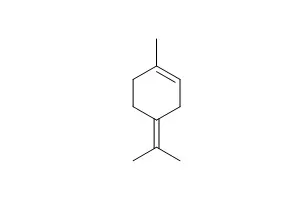| In vitro: |
| Phytomedicine, 2005, 12(6-7):416-423. | | The monoterpene terpinolene from the oil of Pinus mugo L. in concert with α-tocopherol and β-carotene effectively prevents oxidation of LDL.[Reference: WebLink] | Antioxidants from several nutrients, e.g. vitamin E, β-carotene, or flavonoids, inhibit the oxidative modification of low-density lipoproteins. This protective effect could possibly retard atherogenesis and in consequence avoid coronary heart diseases. Some studies have shown a positive effect of those antioxidants on cardiovascular disease. Another class of naturally occurring antioxidants are terpenoids, which are found in essential oils. The essential oil of Pinus mugo and the contained monoterpene Terpinolene effectively prevent low-density lipoprotein (LDL)-oxidation.
METHODS AND RESULTS:
In order to test the mechanism by which Terpinolene protects LDL from oxidation, LDL from human blood plasma enriched in Terpinolene was isolated. In this preparation not only the lipid part of LDL is protected against copper-induced oxidation — as proven by following the formation of conjugated dienes, but also the oxidation of the protein part is inhibited, since loss of tryptophan fluorescence is strongly delayed. This inhibition is due to a retarded oxidation of intrinsic carotenoids of LDL, and not, as in the case of some flavonoids, attributable to a protection of intrinsic α-tocopherol.
CONCLUSIONS:
These results are in agreement with our previous results, which showed the same effects for a monoterpene from lemon oil, i.e. -terpinene. | | Cytotechnology,2015,67:409–418. | | Genotoxic and oxidative damage potentials in human lymphocytes after exposure to terpinolene in vitro.[Reference: WebLink] | Terpinolene (TPO) is a monocyclic monoterpene found in the essential oils of various fir and pine species. Recent reports indicated that several monoterpenes could exhibit antioxidant effects in both human and animal experimental models. However, so far, the nature and/or biological roles of TPO have not been elucidated in human models yet.
METHODS AND RESULTS:
The aim of this study was to investigate the genetic, oxidative and cytotoxic effects of TPO in cultured human blood cells (n = 5) for the first time. Human blood cells were treated with TPO (0–200 mg/L) for 24 and 48 h, and then cytotoxicity was detected by lactate dehydrogenase (LDH) release and [3-(4,5-dimethylthiazol-2-yl)-2,5-diphenyltetrazolium bromide] (MTT) assay, while DNA damage was also analyzed by micronucleus assay, sister chromatid exchanges assay and 8-oxo-2-deoxyguanosine (8-OH-dG) level. In addition, biochemical parameters [total antioxidant capacity (TAC) and total oxidative stress (TOS)] were examined to determine oxidative effects.
The results of LDH and MTT assays showed that TPO (at concentrations greater than 100 mg/L) decreased cell viability. In our in vitro test systems, it was observed that TPO had no genotoxicity on human lymphocytes. Again, TPO (at 10, 25, 50 and 75 mg/L) treatment caused statistically important (p < 0.05) increases of TAC levels in human lymphocytes without changing TOS levels.
CONCLUSIONS:
In conclusion, TPO can be a new resource of therapeutics as recognized in this study with its non-genotoxic and antioxidant features. |
|






 Cell. 2018 Jan 11;172(1-2):249-261.e12. doi: 10.1016/j.cell.2017.12.019.IF=36.216(2019)
Cell. 2018 Jan 11;172(1-2):249-261.e12. doi: 10.1016/j.cell.2017.12.019.IF=36.216(2019) Cell Metab. 2020 Mar 3;31(3):534-548.e5. doi: 10.1016/j.cmet.2020.01.002.IF=22.415(2019)
Cell Metab. 2020 Mar 3;31(3):534-548.e5. doi: 10.1016/j.cmet.2020.01.002.IF=22.415(2019) Mol Cell. 2017 Nov 16;68(4):673-685.e6. doi: 10.1016/j.molcel.2017.10.022.IF=14.548(2019)
Mol Cell. 2017 Nov 16;68(4):673-685.e6. doi: 10.1016/j.molcel.2017.10.022.IF=14.548(2019)